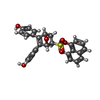[English] 日本語
 Yorodumi
Yorodumi- PDB-5krj: Crystal Structure of the ER-alpha Ligand-binding Domain (Y537S) i... -
+ Open data
Open data
- Basic information
Basic information
| Entry | Database: PDB / ID: 5krj | ||||||
|---|---|---|---|---|---|---|---|
| Title | Crystal Structure of the ER-alpha Ligand-binding Domain (Y537S) in Complex with an a-naphthyl Substituted OBHS derivative | ||||||
 Components Components |
| ||||||
 Keywords Keywords | TRANSCRIPTION / Nuclear receptor / transcription factor / ligand binding / protein-ligand complex | ||||||
| Function / homology |  Function and homology information Function and homology informationregulation of epithelial cell apoptotic process / RNA polymerase II intronic transcription regulatory region sequence-specific DNA binding / antral ovarian follicle growth / regulation of branching involved in prostate gland morphogenesis / RUNX1 regulates transcription of genes involved in WNT signaling / RUNX1 regulates estrogen receptor mediated transcription / regulation of toll-like receptor signaling pathway / nuclear estrogen receptor activity / epithelial cell development / steroid hormone receptor signaling pathway ...regulation of epithelial cell apoptotic process / RNA polymerase II intronic transcription regulatory region sequence-specific DNA binding / antral ovarian follicle growth / regulation of branching involved in prostate gland morphogenesis / RUNX1 regulates transcription of genes involved in WNT signaling / RUNX1 regulates estrogen receptor mediated transcription / regulation of toll-like receptor signaling pathway / nuclear estrogen receptor activity / epithelial cell development / steroid hormone receptor signaling pathway / prostate epithelial cord elongation / epithelial cell proliferation involved in mammary gland duct elongation / prostate epithelial cord arborization involved in prostate glandular acinus morphogenesis / locomotor rhythm / mammary gland branching involved in pregnancy / uterus development / negative regulation of smooth muscle cell apoptotic process / aryl hydrocarbon receptor binding / vagina development / TFIIB-class transcription factor binding / cellular response to Thyroglobulin triiodothyronine / androgen metabolic process / regulation of glucose metabolic process / Synthesis of bile acids and bile salts / regulation of lipid metabolic process / mammary gland alveolus development / cellular response to estrogen stimulus / estrogen response element binding / Synthesis of bile acids and bile salts via 27-hydroxycholesterol / Endogenous sterols / Synthesis of bile acids and bile salts via 7alpha-hydroxycholesterol / Mitochondrial unfolded protein response (UPRmt) / nuclear receptor-mediated steroid hormone signaling pathway / Nuclear signaling by ERBB4 / : / : / Recycling of bile acids and salts / RNA polymerase II preinitiation complex assembly / transcription regulator inhibitor activity / cellular response to hormone stimulus / positive regulation of nitric-oxide synthase activity / estrogen receptor signaling pathway / protein localization to chromatin / steroid binding / : / 14-3-3 protein binding / positive regulation of adipose tissue development / Regulation of lipid metabolism by PPARalpha / TFAP2 (AP-2) family regulates transcription of growth factors and their receptors / peroxisome proliferator activated receptor signaling pathway / negative regulation of canonical NF-kappaB signal transduction / regulation of cellular response to insulin stimulus / BMAL1:CLOCK,NPAS2 activates circadian expression / SUMOylation of transcription cofactors / response to progesterone / ESR-mediated signaling / Activation of gene expression by SREBF (SREBP) / negative regulation of miRNA transcription / TBP-class protein binding / nitric-oxide synthase regulator activity / nuclear estrogen receptor binding / nuclear receptor binding / transcription corepressor binding / transcription coregulator binding / stem cell differentiation / negative regulation of smoothened signaling pathway / SUMOylation of intracellular receptors / circadian regulation of gene expression / cellular response to estradiol stimulus / mRNA transcription by RNA polymerase II / Heme signaling / euchromatin / Transcriptional activation of mitochondrial biogenesis / PPARA activates gene expression / Cytoprotection by HMOX1 / Activated PKN1 stimulates transcription of AR (androgen receptor) regulated genes KLK2 and KLK3 / beta-catenin binding / Transcriptional regulation of white adipocyte differentiation / Nuclear Receptor transcription pathway / response to estrogen / RNA polymerase II transcription regulator complex / transcription coactivator binding / male gonad development / nuclear receptor activity / positive regulation of fibroblast proliferation / Constitutive Signaling by Aberrant PI3K in Cancer / sequence-specific double-stranded DNA binding / positive regulation of nitric oxide biosynthetic process / Regulation of RUNX2 expression and activity / Ovarian tumor domain proteases / : / response to estradiol / PIP3 activates AKT signaling / HATs acetylate histones / positive regulation of cytosolic calcium ion concentration / ATPase binding / MLL4 and MLL3 complexes regulate expression of PPARG target genes in adipogenesis and hepatic steatosis / PI5P, PP2A and IER3 Regulate PI3K/AKT Signaling / regulation of inflammatory response / DNA-binding transcription activator activity, RNA polymerase II-specific Similarity search - Function | ||||||
| Biological species |  Homo sapiens (human) Homo sapiens (human) | ||||||
| Method |  X-RAY DIFFRACTION / X-RAY DIFFRACTION /  SYNCHROTRON / SYNCHROTRON /  MOLECULAR REPLACEMENT / Resolution: 2.7 Å MOLECULAR REPLACEMENT / Resolution: 2.7 Å | ||||||
 Authors Authors | Nwachukwu, J.C. / Srinivasan, S. / Bruno, N.E. / Nowak, J. / Kojetin, D.J. / Elemento, O. / Katzenellenbogen, J.A. / Nettles, K.W. | ||||||
 Citation Citation |  Journal: Cell Chem Biol / Year: 2017 Journal: Cell Chem Biol / Year: 2017Title: Systems Structural Biology Analysis of Ligand Effects on ER alpha Predicts Cellular Response to Environmental Estrogens and Anti-hormone Therapies. Authors: Nwachukwu, J.C. / Srinivasan, S. / Bruno, N.E. / Nowak, J. / Wright, N.J. / Minutolo, F. / Rangarajan, E.S. / Izard, T. / Yao, X.Q. / Grant, B.J. / Kojetin, D.J. / Elemento, O. / ...Authors: Nwachukwu, J.C. / Srinivasan, S. / Bruno, N.E. / Nowak, J. / Wright, N.J. / Minutolo, F. / Rangarajan, E.S. / Izard, T. / Yao, X.Q. / Grant, B.J. / Kojetin, D.J. / Elemento, O. / Katzenellenbogen, J.A. / Nettles, K.W. | ||||||
| History |
|
- Structure visualization
Structure visualization
| Structure viewer | Molecule:  Molmil Molmil Jmol/JSmol Jmol/JSmol |
|---|
- Downloads & links
Downloads & links
- Download
Download
| PDBx/mmCIF format |  5krj.cif.gz 5krj.cif.gz | 207.6 KB | Display |  PDBx/mmCIF format PDBx/mmCIF format |
|---|---|---|---|---|
| PDB format |  pdb5krj.ent.gz pdb5krj.ent.gz | 166.2 KB | Display |  PDB format PDB format |
| PDBx/mmJSON format |  5krj.json.gz 5krj.json.gz | Tree view |  PDBx/mmJSON format PDBx/mmJSON format | |
| Others |  Other downloads Other downloads |
-Validation report
| Summary document |  5krj_validation.pdf.gz 5krj_validation.pdf.gz | 999.8 KB | Display |  wwPDB validaton report wwPDB validaton report |
|---|---|---|---|---|
| Full document |  5krj_full_validation.pdf.gz 5krj_full_validation.pdf.gz | 1006.2 KB | Display | |
| Data in XML |  5krj_validation.xml.gz 5krj_validation.xml.gz | 20.6 KB | Display | |
| Data in CIF |  5krj_validation.cif.gz 5krj_validation.cif.gz | 28 KB | Display | |
| Arichive directory |  https://data.pdbj.org/pub/pdb/validation_reports/kr/5krj https://data.pdbj.org/pub/pdb/validation_reports/kr/5krj ftp://data.pdbj.org/pub/pdb/validation_reports/kr/5krj ftp://data.pdbj.org/pub/pdb/validation_reports/kr/5krj | HTTPS FTP |
-Related structure data
| Related structure data |  5kr9C  5kraC  5krcC 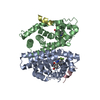 5krfC  5krhC  5kriC  5krkC  5krlC 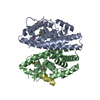 5krmC  5kroC  5tldC 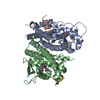 5tlfC 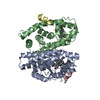 5tlgC  5tllC 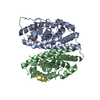 5tlmC  5tloC 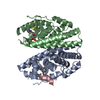 5tlpC  5tltC  5tluC  5tlvC 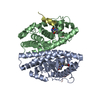 5tlxC 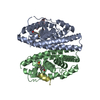 5tlyC  5tm1C  5tm2C  5tm3C  5tm4C  5tm5C  5tm6C  5tm7C  5tm8C  5tm9C  5tmlC  5tmmC  5tmoC  5tmqC 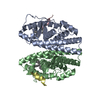 5tmrC 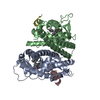 5tmsC 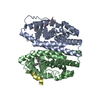 5tmtC  5tmuC 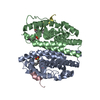 5tmvC  5tmwC 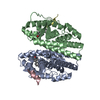 5tmzC  5tn1C  5tn3C  5tn4C  5tn5C 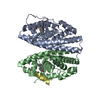 5tn6C  5tn7C 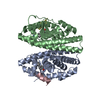 5tn8C C: citing same article ( |
|---|---|
| Similar structure data |
- Links
Links
- Assembly
Assembly
| Deposited unit | 
| ||||||||
|---|---|---|---|---|---|---|---|---|---|
| 1 |
| ||||||||
| Unit cell |
|
- Components
Components
| #1: Protein | Mass: 29299.535 Da / Num. of mol.: 2 / Fragment: ligand-binding domain / Mutation: Y537S Source method: isolated from a genetically manipulated source Source: (gene. exp.)  Homo sapiens (human) / Gene: ESR1, ESR, NR3A1 / Production host: Homo sapiens (human) / Gene: ESR1, ESR, NR3A1 / Production host:  #2: Protein/peptide | Mass: 1666.943 Da / Num. of mol.: 2 / Fragment: Nuclear receptor-interacting peptide / Source method: obtained synthetically / Details: This sequence occurs naturally in humans / Source: (synth.)  Homo sapiens (human) / References: UniProt: Q15596*PLUS Homo sapiens (human) / References: UniProt: Q15596*PLUS#3: Chemical | #4: Water | ChemComp-HOH / | |
|---|
-Experimental details
-Experiment
| Experiment | Method:  X-RAY DIFFRACTION / Number of used crystals: 1 X-RAY DIFFRACTION / Number of used crystals: 1 |
|---|
- Sample preparation
Sample preparation
| Crystal | Density Matthews: 2.03 Å3/Da / Density % sol: 39.29 % / Mosaicity: 1.629 ° |
|---|---|
| Crystal grow | Temperature: 294 K / Method: vapor diffusion, hanging drop / pH: 8.3 / Details: 15% PEG 3350, 0.05M MgCl2, 0.067M NaCl, 0.1M Tris |
-Data collection
| Diffraction | Mean temperature: 100 K | |||||||||||||||||||||||||||||||||||||||||||||||||||||||||||||||||||||||||||||||||||||||||||||||||||||||||
|---|---|---|---|---|---|---|---|---|---|---|---|---|---|---|---|---|---|---|---|---|---|---|---|---|---|---|---|---|---|---|---|---|---|---|---|---|---|---|---|---|---|---|---|---|---|---|---|---|---|---|---|---|---|---|---|---|---|---|---|---|---|---|---|---|---|---|---|---|---|---|---|---|---|---|---|---|---|---|---|---|---|---|---|---|---|---|---|---|---|---|---|---|---|---|---|---|---|---|---|---|---|---|---|---|---|---|
| Diffraction source | Source:  SYNCHROTRON / Site: SYNCHROTRON / Site:  SSRL SSRL  / Beamline: BL11-1 / Wavelength: 1 Å / Beamline: BL11-1 / Wavelength: 1 Å | |||||||||||||||||||||||||||||||||||||||||||||||||||||||||||||||||||||||||||||||||||||||||||||||||||||||||
| Detector | Type: DECTRIS PILATUS 6M / Detector: PIXEL / Date: Apr 3, 2013 | |||||||||||||||||||||||||||||||||||||||||||||||||||||||||||||||||||||||||||||||||||||||||||||||||||||||||
| Radiation | Monochromator: Side scattering bent cube i-beam single crystal asymmetric cut 4.965 degs Protocol: SINGLE WAVELENGTH / Monochromatic (M) / Laue (L): M / Scattering type: x-ray | |||||||||||||||||||||||||||||||||||||||||||||||||||||||||||||||||||||||||||||||||||||||||||||||||||||||||
| Radiation wavelength | Wavelength: 1 Å / Relative weight: 1 | |||||||||||||||||||||||||||||||||||||||||||||||||||||||||||||||||||||||||||||||||||||||||||||||||||||||||
| Reflection | Resolution: 2.4→50 Å / Num. obs: 19194 / % possible obs: 98.8 % / Redundancy: 6.4 % / Rmerge(I) obs: 0.114 / Χ2: 1.104 / Net I/av σ(I): 20.895 / Net I/σ(I): 5.3 / Num. measured all: 122320 | |||||||||||||||||||||||||||||||||||||||||||||||||||||||||||||||||||||||||||||||||||||||||||||||||||||||||
| Reflection shell |
|
- Processing
Processing
| Software |
| |||||||||||||||||||||||||||||||||||||||||||||||||||||||||||||||||||||||||||||||||||||||||||||||||||||||||||||||||||||||||||||||||||||||||||||||||||||||||||||||||||||||||||||||
|---|---|---|---|---|---|---|---|---|---|---|---|---|---|---|---|---|---|---|---|---|---|---|---|---|---|---|---|---|---|---|---|---|---|---|---|---|---|---|---|---|---|---|---|---|---|---|---|---|---|---|---|---|---|---|---|---|---|---|---|---|---|---|---|---|---|---|---|---|---|---|---|---|---|---|---|---|---|---|---|---|---|---|---|---|---|---|---|---|---|---|---|---|---|---|---|---|---|---|---|---|---|---|---|---|---|---|---|---|---|---|---|---|---|---|---|---|---|---|---|---|---|---|---|---|---|---|---|---|---|---|---|---|---|---|---|---|---|---|---|---|---|---|---|---|---|---|---|---|---|---|---|---|---|---|---|---|---|---|---|---|---|---|---|---|---|---|---|---|---|---|---|---|---|---|---|---|
| Refinement | Method to determine structure:  MOLECULAR REPLACEMENT / Resolution: 2.7→47.127 Å / SU ML: 0.37 / Cross valid method: THROUGHOUT / σ(F): 0 / Phase error: 24.84 / Stereochemistry target values: ML MOLECULAR REPLACEMENT / Resolution: 2.7→47.127 Å / SU ML: 0.37 / Cross valid method: THROUGHOUT / σ(F): 0 / Phase error: 24.84 / Stereochemistry target values: ML
| |||||||||||||||||||||||||||||||||||||||||||||||||||||||||||||||||||||||||||||||||||||||||||||||||||||||||||||||||||||||||||||||||||||||||||||||||||||||||||||||||||||||||||||||
| Solvent computation | Shrinkage radii: 0.9 Å / VDW probe radii: 1.11 Å / Solvent model: FLAT BULK SOLVENT MODEL | |||||||||||||||||||||||||||||||||||||||||||||||||||||||||||||||||||||||||||||||||||||||||||||||||||||||||||||||||||||||||||||||||||||||||||||||||||||||||||||||||||||||||||||||
| Refinement step | Cycle: LAST / Resolution: 2.7→47.127 Å
| |||||||||||||||||||||||||||||||||||||||||||||||||||||||||||||||||||||||||||||||||||||||||||||||||||||||||||||||||||||||||||||||||||||||||||||||||||||||||||||||||||||||||||||||
| Refine LS restraints |
| |||||||||||||||||||||||||||||||||||||||||||||||||||||||||||||||||||||||||||||||||||||||||||||||||||||||||||||||||||||||||||||||||||||||||||||||||||||||||||||||||||||||||||||||
| LS refinement shell |
| |||||||||||||||||||||||||||||||||||||||||||||||||||||||||||||||||||||||||||||||||||||||||||||||||||||||||||||||||||||||||||||||||||||||||||||||||||||||||||||||||||||||||||||||
| Refinement TLS params. | Method: refined / Refine-ID: X-RAY DIFFRACTION
| |||||||||||||||||||||||||||||||||||||||||||||||||||||||||||||||||||||||||||||||||||||||||||||||||||||||||||||||||||||||||||||||||||||||||||||||||||||||||||||||||||||||||||||||
| Refinement TLS group |
|
 Movie
Movie Controller
Controller


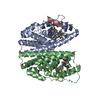
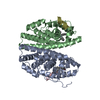
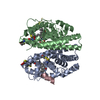
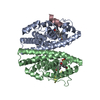
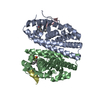
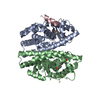




 PDBj
PDBj














